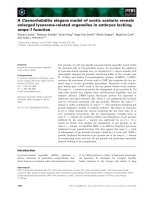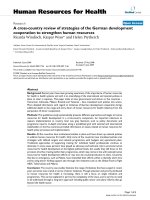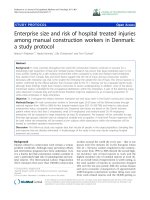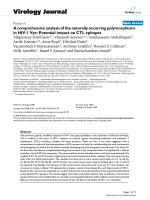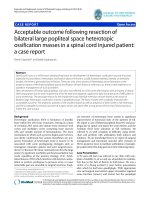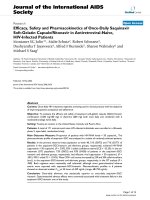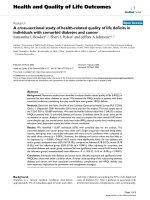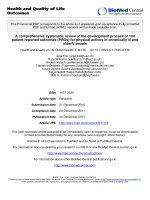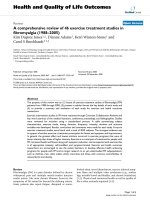báo cáo hóa học:" A comprehensive systematic review of the development process of 104 patient-reported outcomes (PROs) for physical activity in chronically ill and elderly people" pptx
Bạn đang xem bản rút gọn của tài liệu. Xem và tải ngay bản đầy đủ của tài liệu tại đây (435.7 KB, 47 trang )
This Provisional PDF corresponds to the article as it appeared upon acceptance. Fully formatted
PDF and full text (HTML) versions will be made available soon.
A comprehensive systematic review of the development process of 104
patient-reported outcomes (PROs) for physical activity in chronically ill and
elderly people
Health and Quality of Life Outcomes 2011, 9:116 doi:10.1186/1477-7525-9-116
Anja Frei ()
Kate Williams ()
Anders Vetsch ()
Fabienne Dobbels ()
Laura Jacobs ()
Katja Rudell ()
Milo A. Puhan ()
ISSN 1477-7525
Article type Research
Submission date 21 December 2010
Acceptance date 20 December 2011
Publication date 20 December 2011
Article URL />This peer-reviewed article was published immediately upon acceptance. It can be downloaded,
printed and distributed freely for any purposes (see copyright notice below).
Articles in HQLO are listed in PubMed and archived at PubMed Central.
For information about publishing your research in HQLO or any BioMed Central journal, go to
/>For information about other BioMed Central publications go to
/>Health and Quality of Life
Outcomes
© 2011 Frei et al. ; licensee BioMed Central Ltd.
This is an open access article distributed under the terms of the Creative Commons Attribution License ( />which permits unrestricted use, distribution, and reproduction in any medium, provided the original work is properly cited.
1
A comprehensive systematic review of the development process of
104 patient-reported outcomes (PROs) for physical activity in
chronically ill and elderly people
Anja Frei
1,2§
, Kate Williams
3
, Anders Vetsch
1,2
, Fabienne Dobbels
4
, Laura Jacobs
5
, Katja
Rüdell
3
, Milo A. Puhan
1,6
1
Horten Centre for Patient-oriented Research, University Hospital of Zurich, Switzerland
2
Institute of General Practice and Health Services Research, University Hospital of Zurich,
Switzerland
3
Patient Reported Outcomes Centre of Excellence, Global Market Access, Primary Care
Business Unit, Pfizer Ltd, Walton Oaks, Surrey, United Kingdom
4
Centre for Health Services and Nursing Research, post-doctoral researcher FWO Vlaanderen,
Katholieke Universiteit Leuven, Leuven, Belgium
5
Respiratory Sciences, Katholieke Universiteit Leuven, Leuven, Belgium
6
Department of Epidemiology, Johns Hopkins Bloomberg School of Public Health, Johns
Hopkins University, Baltimore (MD), USA
§
Corresponding author
Email addresses:
AF:
, KW: , AV: ;
FD: , LJ: , KR:
, MAP:
2
Abstract
Background
Capturing dimensions of physical activity relevant to patients may provide a unique
perspective for clinical studies of chronically ill patients. However, the quality of the
development of existing instruments is uncertain. The aim of this systematic review was to
assess the development process of patient-reported outcome (PRO) instruments including
their initial validation to measure physical activity in chronically ill or elderly patient
populations.
Methods
We conducted a systematic literature search of electronic databases (Medline, Embase,
Psychinfo, Cinahl) and hand searches. We included studies describing the original
development of fully structured instruments measuring dimensions of physical activity or
related constructs in chronically ills or elderly. We broadened the population to elderly
because they are likely to share physical activity limitations. At least two reviewers
independently conducted title and abstract screening and full text assessment. We evaluated
instruments in terms of their aim, items identification and selection, domain development,
test-retest reliability, internal consistency, validity and responsiveness.
Results
Of the 2542 references from the database search and 89 from the hand search, 103 full texts
which covered 104 instruments met our inclusion criteria. For almost half of the instruments
the authors clearly described the aim of the instruments before the scales were developed. For
item identification, patient input was used in 38% of the instruments and in 32% adaptation of
existing scales and/or unsystematic literature searches were the only sources for the
3
generation of items. For item reduction, in 56% of the instruments patient input was used and
in 33% the item reduction process was not clearly described. Test-retest reliability was
assessed for 61%, validity for 85% and responsiveness to change for 19% of the instruments.
Conclusions
Many PRO instruments exist to measure dimensions of physical activity in chronically ill and
elderly patient populations, which reflects the relevance of this outcome. However, the
development processes often lacked definitions of the instruments’ aims and patient input. If
PROs for physical activity were to be used in clinical trials more attention needs to be paid to
the establishment of content validity through patient input and to the assessment of their
evaluative measurement properties.
4
Background
Physical activity is crucial to chronically ill patients’ functioning in daily life. The
evidence of the protective role of physical activity for the prevention and management of
chronic diseases has been well established over recent decades [1, 2]. Physical activity is a
multidimensional construct and defined as “any bodily movement produced by the
contraction of skeletal muscle that increases energy expenditure above a basal level” [3].
The assessment of physical activity as an outcome measure provides a unique
perspective in chronic disease research not only for observational studies, but also for drug
and nondrug clinical trials. Furthermore, evidence from trials regarding physical activity as a
patient-reported outcome (PRO) could inform patients about treatment options that address
relevant aspects of their daily life. Investigators who are interested in measuring physical
activity face the challenge of not only choosing an instrument that serves their study aim, but
that has also been carefully developed and validated. These instruments should have strong
psychometric properties such as stability over time (test-retest reliability) and the capacity to
detect even small effects (responsiveness to change). In addition, investigators need to be
certain that the instruments reflect the dimensions of physical activity that are relevant to
patients.
It is currently unclear whether available instruments to measure physical activity fulfil
these requirements. Therefore, the aim of this systematic review, which is part of the
Innovative Medicines Initiative PROactive project (
; a project
jointly funded by the European Commission and the European Federation of Pharmaceutical
Industries and Associations ‘EFPIA), was to identify existing fully structured PROs
(questionnaires, scales) measuring physical activity (frequency, intensity and total amount),
and/or symptoms (physical and mental) or complaints/concerns associated with physical
activity in chronically ill or elderly patient populations. We broadened the population to
elderly because they are likely to share some characteristics regarding physical activity with
5
chronically ill patients. Furthermore, the systematic review aimed to evaluate the
methodological rigour with which the retrieved instruments were developed and initially
validated as a part of the development process. Therefore, we restricted our review to the first
validations of the instruments as part of the development process. In this paper we focused on
the methods used in the development of the physical activity instruments. The content and the
format of the included instruments are reviewed in another paper.
6
Methods
A study protocol (unregistered) guided the entire review process. We followed standard
systematic review methodology as outlined in the handbooks of the Centre for Reviews and
Dissemination [4] and the Cochrane Collaboration. The reporting follows the PRISMA
statement that recently replaced the former guidelines of reporting of systematic reviews and
meta-analyses (QUOROM statement) [5].
Eligibility criteria
We considered the following criteria for inclusion and exclusion:
Population
We included PRO instruments developed for patients with chronic disease or elderly people.
Elderly people were included because chronic illnesses usually affect people in later stages of
life. In addition, we supplemented the electronic database search with explicit search terms for
COPD patients. This is because this systematic review is part of the PROactive project, which
aims to develop and validate two PRO instruments for COPD patients [6].
Types of instrument
We included fully structured instruments (scales or questionnaires) with standardised
questions and answer options which were reported by the patient (self-reported). We only
included interviewer administered instruments if the information was self-reported by the
patient and we excluded instruments that required a rating by an interviewer.
Content of instrument / assessment of physical activity
We included instruments measuring dimensions of physical activity or related constructs. We
considered the following definition for physical activity according to the U.S. Department of
Health and Human Services [3]: “Physical activity is defined as any bodily movement
produced by the contraction of skeletal muscle that increases energy expenditure above a
basal level”. This definition of physical activity is broad and encompasses activities of daily
7
living, sports and activities for personal fulfilment. We did not restrict the search to
instruments measuring the frequency, intensity and total amount of physical activity, but also
considered instruments assessing “related constructs” and/or subscales that focused on
symptoms (physical and mental) or complaints/concerns associated with physical activity. All
of the instruments we included contained at least one physical activity subscale. We only
included instruments whose items we could access from the publication or from the
developers. We did not have any language or publication date restrictions.
Study design
We included both cross-sectional and longitudinal studies which described the development
(including item generation, piloting etc) or modifications of the original instrument and the
initial validation (psychometric properties, cross-sectional or longitudinal) of the original
instrument. Since we focused on the methods used for the development process of the
instruments, the article had to describe a minimum of the development or first validation
process, for example, a description about item identification or selection and/or at least one
assessment of test-retest, responsiveness or validity in a publication that was clearly the
original. We excluded studies that used an eligible instrument as an outcome measure and
were not designed to initially validate this instrument. We also excluded studies that reported
the validation of instruments in additional languages and/or populations.
Information sources
Electronic database searches
We searched the electronic databases Medline, Embase, PsycINFO and CINAHL on
September 18th 2009.
Hand searches
We conducted the following hand searches to complement the electronic database search
results: We searched for original development studies of instruments from articles which were
excluded for the reason “validation only” or “used as outcome measures”; we scanned the
8
reference lists of the full texts; we searched the Patient-Reported Outcome and Quality of Life
Instruments Database (PROQolid) on March 10 2010, search term: “physical functioning”
questionnaires; and we contacted experts in the field and asked them to check if our list of
included instruments was complete or if we missed any instruments.
Search
For the electronic database search, we used the following search terms: (physical activity OR
functioning OR function OR motor activity OR activities of daily living OR walking OR
activity OR exercise) AND (questionnaire* OR scale OR instrument OR tool OR diary OR
assessment OR self-report OR measure*) AND (valid*) AND (chronic disease OR elderly
OR COPD OR chronic lung disease OR chronic obstructive lung disease) NOT (athletic
performance OR sports OR children OR adolescent).
Study selection
Title and abstract screening
Two pairs of two reviewers each used a title and abstract screening document to
independently review the title and abstract of every article retrieved by the database search.
Decisions to include or exclude were recorded in the RefWorks-COS file (0 = exclude, 1 =
order for full text assessment, 2 = only validation study of existing instrument, 3 = related
study (e.g. reviews), do not order but may be useful reference). We ordered all articles that
were deemed potentially eligible by at least one reviewer.
Full text screening
Two pairs of two reviewers each independently evaluated the full texts and made a decision
on inclusion or exclusion according to the predefined selection criteria. They recorded their
decision on a paper form together with the reason for exclusion (not relevant patient group;
instrument does not measure dimensions of physical activity or related constructs; instrument
is not self-reported (e.g. functional or exercise test like time to stand up from a chair or 6
9
minutes walking test); instrument with all its items is not available from the publication or
from the developers; instrument is used as an outcome measure/study is not designed to
validate this instrument, respectively; validation study only (e.g. additional languages,
populations etc.); other). If the two reviewers could not agree, a third reviewer decided
whether to include or exclude. Studies that did not fulfil all of the predefined criteria were
excluded and their bibliographic details were listed with the specific reason for exclusion.
Piloting the study selection process
Initially, all reviewers piloted the selection process by applying the inclusion and exclusion
criteria to the 50 first references for titles and abstracts screening and the first 30 papers for
full text assessment. Inclusion and exclusion criteria were refined and clarified based on this
piloting process.
Dealing with lack of information
We made three attempts to contact authors by e-mail in the following conditions: 1) If it was
unclear from the full text article whether the study fulfilled the inclusion and exclusion
criteria; 2) If the included development study lacked information on how the instrument was
developed in order to complete data extraction; 3) If the included development study lacked
information on the instrument’s content (items, introduction question, recall period etc.). If we
failed to retrieve the relevant information from the author, this was reported on the data
extraction form.
Dealing with duplicate publications
In cases where multiple papers were published (e.g. translations, reporting on different
outcomes etc.), we treated the study with multiple reports as a single study but made reference
to all publications.
Data extraction process
We created standardised data extraction forms based on a form used in a previous review [7]
to record the relevant information from the articles. The data extraction forms were piloted
10
twice by four reviewers including 8 instruments for the first and 6 instruments for the second
pilot. The forms and categories were then adapted and refined where necessary. The first
reviewers extracted the data and stored it in a MS Word file. The second reviewers then
independently extracted the data and compared their results with that of the first reviewers.
These changes were made using the ‘track changes’ mode. The file was sent back to the first
reviewer in order to come to an agreement. When an agreement could not be reached a third
reviewer was consulted.
Data extraction
We extracted data from the development studies regarding the instruments’ development and
initial validation process. We used pre-defined categories and answer options including
numerical indications, fixed texts such as “yes/no”, multiple choice and free text. We
extracted data for the following categories:
Development of instruments
Aim of instrument
We distinguished between 3 categories: First, if the aim of the instrument was clearly
described by the authors before the instrument was developed, the classification was
“described”. We differentiated between the four aims “evaluative” (detection of changes over
time, typically for evaluation of treatments), “discriminative” (detection of differences
between patients, e.g. for phenotyping), “predictive” (prediction of future health outcomes,
e.g. hospital admissions or death) and “planning” (planning of treatment, e.g. detection of
areas with low scorings to target patient education accordingly). Second, if the aim was not
explicitly described by the authors before development but could be identified from the
context, the classification was "not clearly described, but presumably (e.g. evaluative)". Third,
if the purpose of the instrument was not reported and could not be identified we used the
classification "not described".
11
Identification of items
To describe the identification of the items, we differentiated between five categories of
sources of item generation (several answer options possible): patients and elderly (target
population); experts (e.g. clinical experts, health professionals, care givers etc., also includes
supplementation or modification of existing items through experts); significant others (e.g.
family members, care givers); literature; and adaptation of existing instruments. We also
described the method of item identification in brackets, for example, interviews or focus
groups, systematic or unsystematic searches.
Selection of items
We reported the approach used by the authors to select items for the final instrument by
differentiating between the following four sources: patients quantitative; patients qualitative;
experts quantitative; experts qualitative. We provided specific details in brackets, for
example, “Patients: quantitative (e.g. factor analysis)”, “Patients: qualitative (e.g. focus
group)”, “Experts: quantitative (e.g. relevance)” or “Experts: qualitative (e.g. interviews)”.
Development of domains
We recorded the method of how the domains were defined, i.e. if they were defined a priori
(the authors predefined domains and items which belong to these domains without statistical
analyses but based on their clinical/research experience or opinion) or if domains were
statistically defined by factor analysis.
Initial validation of instruments
Test-retest
12
We recorded if test-retest reliability (reproducibility) was examined and described the
statistical method used, for example, intra-class correlation coefficients, coefficient of
variation, Pearson or Spearman correlation coefficients or t-tests.
Internal consistency
We recorded if internal consistency reliability was assessed and described the statistical
method used, for example, Cronbach’s alpha, corrected item total correlation or Cronbach’s
alpha excluding item analysis.
Validity
We recorded if validity was assessed and if so, the type of validity that the authors described
to assess (in quotation marks) and the statistical methods used (in brackets).
Responsiveness
We recorded any approaches to assess responsiveness (i.e. the ability of an instrument to
detect changes over time) and we reported the statistical methods used.
Minimal important difference (MID)
We reported if the MID was examined and the statistical methods (e.g. anchor- or
distribution-based approaches) used.
Summary of conducted initial validation assessments according to aim of instrument
The aim of the instrument determines the measurement properties, which should be assessed
in the validation process. The assessment of test-retest reliability and internal consistency is
important for each instrument development, regardless of whether the instrument’s aim is
evaluative, discriminative, predictive or planning. For instruments with an evaluative aim, the
longitudinal testing of the validity is of special interest whereas for instruments with
13
discriminative or planning aims, cross-sectional testing of the validity is sufficient. For
instruments with evaluative aims, the assessment of responsiveness and the MID is crucial
because they aim to detect changes over time.
We summarised the assessed psychometric properties of the instruments for which the authors
clearly described an aim before the instruments was developed.
Synthesis of results
We described the results of the data extraction in structured tables according to the categories
described above (see Additional file 1). We synthesised the data on the instruments’
development and initial validation in a narrative way and in integrated tables. We used
numbers and proportions to describe the results quantitatively. These frequencies were
calculated using SPSS (Version 18.0).
14
Results
Study selection
Figure 1 shows the flow diagram of the identification of the studies. The electronic database
search produced 2542 references. After title and abstract screening, 2268 of these were
excluded resulting in 274 articles for full text assessment. This included 5 Japanese and one
Chinese language article which were provisionally included due to their English abstract but
were not included in the current analysis as we were unable to translate them [8-13]. Hand
searches of reference sections and of excluded articles revealed an additional 70
instruments/development studies for full text assessment. The search of the PROQolid
database produced a further 58 instruments, 19 of which were included for full text
assessment after title and abstract screening. One additional instrument was retrieved from the
consultation with experts. Therefore, a total of 364 papers were included for full text
assessment.
Following full text assessment, a further 255 were excluded resulting in 104 instruments from
103 full texts (the article of Mannerkorpi & Hernelid (2005) [14] provided information for the
development process of two instruments) included in the review [14-117]. The most frequent
reasons for exclusion were instrument is not self-reported (n = 71), followed by instrument
does not measure physical activity (n = 66), validation study only (n = 35) and instrument
used as an outcome measure (n = 29). The references of all excluded articles after full text
assessment are summarised in Additional file 2.
Study characteristics
Additional file 1 summarises the extracted data for the development and initial validation
process of the reviewed instruments.
15
Aim of instrument
For almost half of the instruments (n = 49, 47.1%), the authors clearly described the aim of
the instruments before the scales were developed. One aim was described for 26 instruments
(53.1%) and more than one for 23 instruments (46.9%). The most frequently described aim
was evaluative (n = 33), followed by discriminative (n = 26), planning (n = 13) and
predictive (n = 5). For 43.3% of the instruments (n = 45), the authors did not clearly describe
one or several aims but they could be presumed from the context (presumably discriminative:
n = 32, presumably evaluative: n = 24, presumably planning: n = 9, presumably predictive: n
= 9). For 10 instruments (9.6%), the authors did not describe an aim.
Identification of items
For 39 instruments (37.5%) items were identified with patient input, either with patient input
only or with patient input together with other sources (adaptation of existing instruments,
experts and/or literature). Adaptation of existing instruments and/or unsystematic literature
searches only were the source for item identification of 33 instruments (31.7%), and expert
input only or expert input additionally to literature and adaptation was the source for item
identification of 14 instruments (13.5%). For the development of 18 instruments (17.3%),
item identification was not reported or not clearly described. Table 1 describes the sources
which were used to identify the items of the included instruments, ordered by frequency.
The most frequently used method to generate patient input was “interviews with patients”
only (for 24 of 39 instruments). Focus groups were less frequently conducted (for 5 of 39
instruments) and for only 1 instrument both interviews and focus groups were conducted. For
7 instruments, the method of generating patient input was not reported and for 2 instruments,
patient input was described as “clinical interactions” or “open ended survey”. The methods
used to obtain expert input were more diverse and varied from interviews with experts to
workshops, ratings of relevance, unspecified discussions and undefined consideration of
clinical opinion. Literature searches were always conducted unsystematically.
16
Selection of items
For 58 instruments (55.8%), patient input was used for item reduction, and for 12 instruments
(11.5%) the items were selected by expert input only. For 34 instruments (32.7%), item
reduction was not clearly described (see Table 2). Where patient input was used for item
selection (n = 58), the methods were predominantly quantitative (n = 31, 53.4%) and
conducted by factor analysis (17 of 31 instruments). Less frequently used methods included
item-total correlations, Rasch analyses and consideration of response rates and floor/ceiling
effects. Qualitative methods, either alone or in addition to quantitative methods, were used in
the selection of items for 46.6% (n = 27) of the instruments. Most frequently, qualitative
patient input for item selection was generated by patient interviews (10 of 27 instruments).
Less frequently focus groups and cognitive interviews/debriefings were used.
Development of domains
The domains were more often developed by factor analysis (n = 36, 34.6%) than by a priori
specifications (n = 16, 15.4%). For half of the instruments, the development of the domains
was not reported (n = 42, 40.4%) or was not applicable (n = 8, 7.7%). The domains of two
instruments were developed by Rasch analysis.
Test-retest
Test-retest reliability was assessed for 63 instruments (60.6%). The most frequently used
statistical methods were intraclass correlation coefficients either alone (n = 18) or together
with other methods (n = 5). This was followed by Pearson correlation coefficient (n = 10),
unspecified correlations (n = 9), various types of t-tests (either alone or together with other
methods, n = 6) and various other methods (n = 15). 41 development studies (39.4%) did not
report on assessing test-retest reliability.
17
Internal consistency
Internal consistency was assessed in 62 development studies (59.6%). Most frequently
internal consistency was assessed by Cronbach’s alpha alone (n = 46) or Cronbach’s alpha
together with other methods (n = 10).
Validity
Eighty-eight studies reported on the assessment of validity (84.6%). The most frequently
assessed type of validity that the authors described was construct validity (n = 43), followed
by convergent/convergence validity (n = 19), discriminant validity (n = 18), concurrent
validity (n = 16), content validity (n=12), criterion validity (n = 11), predictive validity (n =
6), divergent validity (n = 4) and face validity (n = 4). For 25 instruments, the authors did not
specify or name the type of validity tested. Most authors reported several types of validity.
Validity was most frequently assessed with a correlational approach.
Responsiveness
The assessment of responsiveness was reported for 20 instruments only (19.2%). Several
methods were used.
MID
Only 3 development studies reported on the MID (2.9%).
Summary of initial validation assessments according to aim of instrument
Table 3 refers to the instruments for which an aim was clearly described before the instrument
was developed (n = 49, some studies described more than one aim). The table shows the
number and percentage of instruments which assessed each psychometric property. The
majority of instruments with a defined aim assessed validity in the initial validation process,
regardless of the kind of aim, whereas test-retest was assessed for fewer instruments. For
18
40.6% of the instruments with an evaluative aim, responsiveness was assessed and the MID
for 6.3%.
19
Discussion
Our systematic review showed that there are many existing PRO instruments
measuring various dimensions of physical activity, highlighting the importance of this
concept as an outcome measure. The methodological quality of the development process
varied considerably across the 104 included instruments. For the majority of the instruments,
the aim either was not clearly described or not described at all before the instruments were
developed. In addition, patients were often not involved in the item identification process of
new instruments, making the adaptation of existing scales, unsystematic literature searches
and/or expert input the only sources of item generation. Several instruments used quantitative
patient input for item selection, but a surprisingly high number of studies did not describe or
report on how items were selected. Also, the quality of the initial validation varied widely
between the instruments. Internal consistency and test-retest reliability were assessed more
frequently than responsiveness to change. The MID was estimated for only 3 instruments.
Some instruments defined an evaluative aim; however, responsiveness was assessed in less
than half of these. Many studies assessed construct validity while content validity was
assessed for only a minority of the instruments.
Over the last decades, physical activity instruments were traditionally used
predominantly in epidemiological research to measure physical activity as a potential
determinant of health outcomes [1, 2]. This requires that the instruments are able to
discriminate between people in order to identify different levels of physical activity that might
be associated with different health outcomes. In recent years, there has been growing interest
in physical activity as a PRO measure. For example in obesity research, studies examine the
effect of interventions on physical activity [118-120]. The use of physical activity instruments
as outcome measures has implications for the development and initial validation process of
these scales. Since PROs should be able to detect changes over time, their evaluative power is
essential. Consequently, development and initial validation studies should go beyond cross-
20
sectional studies and assess responsiveness to change and the MID in prospective follow-up
studies [7].
PROs for symptoms, health-related quality of life but also for physical activity have
become a prevalent outcome in clinical trials. Over the last ten years many new PROs have
been developed and validated and it can be expected that in the near future an increasing
number of claims on the effectiveness of drugs will be made based on PROs. As a
consequence, both the U.S. Food and Drug Administration (FDA) and the European
Medicines Agency (EMA) have developed guidance documents on the requirements for PRO
instruments that would allow making drug claims. A key evaluation point for the FDA is the
evidence on content validity. Content validity describes the extent of how the instrument
measures the concept of interest, which is specific to the population, condition and treatments
to be studied. The FDA explicitly asks for patient input for item generation through
qualitative research to ensure content validity in the development process of a new instrument
[121-123].
Although all of the PRO instruments included in this systematic review were
developed before the finalisation of the FDA guidance document in December 2009, it is still
surprising that in less than one third of the included studies authors reported on qualitative
research for item generation such as patient interviews or focus groups, and a minority
declared explicitly to have tested content validity of the newly developed instruments. These
findings, along with the fact of poor reporting on item selection methods, indicate that only
few physical activity PRO instruments would currently fulfil the FDA and EMA requirements
for outcome measures. While the need to establish content validity has been recognised for
many years, there has been little pressure to conduct qualitative research as illustrated in our
systematic review. This is likely to change; at least in the field of clinical trials as
investigators developing new instruments can now follow the FDA and EMA guidance to
establish content validity more formally through qualitative research. Existing instruments are
in a more difficult position, although they may in retrospect support their relevance to patients
21
through additional qualitative research. For example, one may examine whether the constructs
measured by existing instruments align with what patients perceive to be important, or if
important aspects are missing.
One strength of this systematic review was the adherence to rigorous systematic
review methodology along with the broad search strategy to identify existing physical activity
instruments and subscales/domains. We supplemented the systematic database searches by a
comprehensive hand search as well as by a PROQolid database search. As we aimed to
identify any relevant instruments, we kept the inclusion criteria broad by using the definition
for physical activity as described in the “2008 Physical activity guideline for Americans” [3].
Such a broad perspective could also be perceived as a limitation. Although we paid great
attention to carefully defining the inclusion criteria, we cannot exclude the possibility of
having missed questionnaires. Also, the decision about inclusion or exclusion of the
instruments was sometimes ambiguous as for example for instruments assessing specific
types of physical activity for chronic illnesses such as multiple sclerosis or chronic pain. In
such cases we tried to adopt systematically and scientifically defendable decision criteria for
inclusion or exclusion. For multiple sclerosis patients, for example, we did not consider
physical activity instruments aiming at impaired hand motor activity but we included those
assessing physical activity limitations which are more general and which could also be
relevant for other chronic illnesses like “Walking ability” [54] or “Physical functioning” [93].
Another example includes activity limitations due to pain, where we excluded some
instruments such as those targeting specialised pain coping activities, but included
instruments such as the Activities of Daily Living Scale [71]. We focused solely on
publications of the development and initial validation, which to some extent may
underestimate the rigour of the overall development process. Undoubtedly some instruments
might have had additional validation studies which we have not included in this review.
However, we suspect that many instruments were introduced into research and practice rather
rapidly without further validation, and, if validations were conducted during the development
22
process, it is likely that the authors would have published these results as part of the
development paper.
Conclusion
Our systematic review showed that there are many existing PRO instruments
measuring physical activity in chronically ill and elderly patient populations, highlighting the
importance of this concept as an outcome measure. However, the development processes
often lacked definitions of the instruments’ aims and patient input. If PROs for physical
activity are to be used in clinical trials, there needs to be more focus on establishing content
validity through patient input, and assessing their evaluative measurement properties.
23
Competing interests
Anja Frei, Anders Vetsch, Fabienne Dobbels, Laura Jacobs and Milo Puhan have no
competing interests. Katja Rüdell is an employee of Pfizer Ltd and Kate Williams is
contracted by Pfizer Ltd. The current work is methodological and provides no competitive
advantage or disadvantage. No medical writers were used to support the writing of this
manuscript.
Authors' contributions
MP and KR led the systematic review. MP, KR, AF, FD and LJ developed the conceptual
framework and the study protocol. MP, KR and AF coordinated the review. MP, FD, KR and
AF conducted the electronic database searches; KW, AV, AF, KR and MP conducted the
additional searches. AF coordinated the references in RefWorks. KR and FD (1
st
reviewers),
KW and LJ (2
nd
reviewers) and MP and AF (3
rd
reviewers) screened titles and abstracts. KW
and KR (1
st
reviewers), AF and AV (2
nd
reviewers) and MP (3
rd
reviewer) assessed full texts
of the identified studies and extracted the relevant data. AF conducted the statistical analysis.
AF and MP drafted the manuscript. All authors contributed to revising the manuscript and
approved the final version.
Authors' information
Katja Rüdell is an honorary lecturer of health psychology at the University of Kent, UK
Acknowledgements
24
The study was conducted within the PROactive project which is funded by the Innovative
Medicines Initiative Joint Undertaking (IMI JU # 115011). The authors would also like to
thank Laura Jacobs for her support in the early stages of the project as well as the PROactive
group: Caterina Brindicci and Tim Higenbottam (Chiesi Farmaceutici S.A.), Thierry Trooster
and Fabienne Dobbels (Katholieke Universiteit Leuven), Margaret X. Tabberer (Glaxo Smith
Kline), Roberto Rabinovitch and Bill McNee (University of Edinburgh, Old College South
Bridge), Ioannis Vogiatzis (Thorax Research Foundation, Athens), Michael Polkey and Nick
Hopkinson (Royal Brompton and Harefield NHS Foundation Trust), Judith Garcia-Aymerich
(Municipal Institute of Medical Research, Barcelona), Milo Puhan and Anja Frei (Universität
of Zürich, Zürich), Thys van der Molen and Corina De Jong (University Medical Center,
Groningen), Pim de Boer (Netherlands Asthma Foundation, Leusden), Ian Jarrod (British
Lung Foundation, UK), Paul McBride (Choice Healthcare Solution, UK), Nadia Kamel
(European Respiratory Society, Lausanne), Katja Rudell and Frederick J. Wilson (Pfizer Ltd),
Nathalie Ivanoff (Almirall), Karoly Kulich and Alistair Glendenning (Novartis), Niklas X.
Karlsson and Solange Corriol-Rohou (AstraZeneca AB), Enkeleida Nikai (UCB) and
Damijen Erzen (Boehringer Ingelheim).
